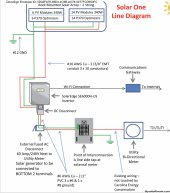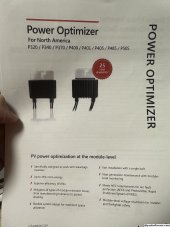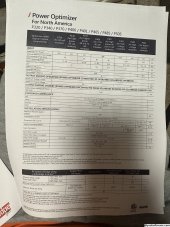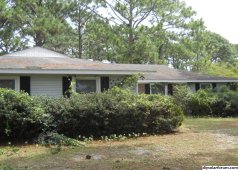I currently have a 6.8kw system (20x340 Q Peak Duo) I had installed a few years ago with a solar edge inverter SE6000H (grid tied). I was told that I can't just swap inverters. So I'm asking for information on what I would have to do specifically to hook up these panels to a EG4 18k Inverter. These companies want stupid money and also want to sell me a new system.
You are using an out of date browser. It may not display this or other websites correctly.
You should upgrade or use an alternative browser.
You should upgrade or use an alternative browser.
Changing out a solar edge inverter
- Thread starter Bricktop
- Start date
zanydroid
Solar Wizard
Very few companies want to do solar retrofit when the economy is in a good state... why would they do something with higher liability, much harder design, while also making a fraction of the money... not incentive aligned at all.
Couple threads on your problem already, so the path is really well tread. For instance y0bailey just went through the exact same journey and you can just read their threads and copy their strategy.
The TLDR is that most people end up AC coupling the SE inverter to a AC-coupling capable inverter like 18kpv. It's good that you picked something that expensive b/c lower cost hardware is not super capable of AC coupling at this point in human history.
Your other option is to rip out all the optimizers (and replace them with RSD if roof mount). Assuming the layout of the panels and strings is compatible with doing that. Needs a lot of sophistication to do properly. Well, not rocket science, but far from blind swap and pray.
Couple threads on your problem already, so the path is really well tread. For instance y0bailey just went through the exact same journey and you can just read their threads and copy their strategy.
The TLDR is that most people end up AC coupling the SE inverter to a AC-coupling capable inverter like 18kpv. It's good that you picked something that expensive b/c lower cost hardware is not super capable of AC coupling at this point in human history.
Your other option is to rip out all the optimizers (and replace them with RSD if roof mount). Assuming the layout of the panels and strings is compatible with doing that. Needs a lot of sophistication to do properly. Well, not rocket science, but far from blind swap and pray.
thank you for the response. I will check out other threads. I just joined today but have been reading a lot trying to learn more.
my other issue I had thought about is expanding my system size by adding panels. Especially if they are likely not to be the same. Even if I got the same my solar edge inverter would need upgraded to a larger one correct? Just thinking maybe sell this system and purchase a different/larger system and get the EG4 inverter and go from there.
my other issue I had thought about is expanding my system size by adding panels. Especially if they are likely not to be the same. Even if I got the same my solar edge inverter would need upgraded to a larger one correct? Just thinking maybe sell this system and purchase a different/larger system and get the EG4 inverter and go from there.
zanydroid
Solar Wizard
Seems that you are unfamiliar with the advantages of using SolarEdge optimizers. Optimizers will elide the differences between panels, whether it's from being oriented differently, shaded, or being different sizes. Optimizers also have a huge advantage for installers in that it lets them YOLO/be kind of dumb about design, vs having to be careful and elegant with optimizer-less design. The disadvantage is that SolarEdge optimizers only work with SolarEdge inverters.thank you for the response. I will check out other threads. I just joined today but have been reading a lot trying to learn more.
my other issue I had thought about is expanding my system size by adding panels. Especially if they are likely not to be the same. Even if I got the same my solar edge inverter would need upgraded to a larger one correct? Just thinking maybe sell this system and purchase a different/larger system and get the EG4 inverter and go from there.
I do not know what ratio of difference SolarEdge is able to bridge, it's probably at least 5:1 (and if there is a difference in power output greater than that, might as well just bypass and abandon the solar panel).
Whether you need a larger inverter depends on how much of the inverter capacity is being used. SE6000H is pretty small IMO at 6kW. So there is a decent chance you're close to maxing out on it (EDIT: I didn't see the 6.8kW DC size in your original post. Yeah it's maxed out). Another limit is the maximum number of optimizers allowed per string. This is documented in the spec sheet for the optimizer you might be interested in buying. SolarEdge goes up to 11kW per inverter. You can expand by either adding another inverter (which would most likely require running a new string) and AC coupling them to each other on the inverter output, or swapping the inverter (and then you can add onto the existing string). Whether extending string or adding a new one is better/worse depends a lot on details of how you plan to expand.
If you sell this system you need to expend labor to unmount the optimizers. Are you qualified to do that/going to do that yourself? Are you good at hiring companies like this? How much are your optimizers worth? Check on eBay for the exact optimizers you bought. The most time-optimal way to do this is to install the RSD and rerun the DC string to match what the new inverter requires, at the time that the optimizers are removed.
Keep in mind that sales person may not be the best designer (a handful are OK) and don't really have the bandwidth/incentives to explain everything to you correctly.
Quattrohead
Solar Wizard
AC couple your Solaredge system to an 18kpv and batteries is your easiest method, no messing with your present system.
Otherwise you would have to remove the solaredge optimizers, replace them with a different fire safety cutoff system etc.
If you want to add more panels you can connect them to the 18kpv directly....or via Tigo devices if required.
Otherwise you would have to remove the solaredge optimizers, replace them with a different fire safety cutoff system etc.
If you want to add more panels you can connect them to the 18kpv directly....or via Tigo devices if required.
zanydroid
Solar Wizard
The best way to expand IMO is to put a decent fraction of new panels on the MPPT on the 18kpv. Some of these hybrids do better if they have DC coupled solar in addition to solar coming off an AC coupled system.
Now you might add more SolarEdge optimizers if you want to squeeze panels in weird parts of the roof, that would be difficult to put on an MPPT without optimizers. This gets tricky to cost optimize b/c your inverter is maxed out.
If you post a crapton of details about your setup, like pictures of roof, orientation information, location in US, performance goals and requirements, you might be able to get a pretty good crowdsourced design. With the details you have provided so far, not so much.
IMO if you can get the appropriate traction and attention on a post here you can end up with a design that would otherwise require you to engage a top-quality contractor for.
Now you might add more SolarEdge optimizers if you want to squeeze panels in weird parts of the roof, that would be difficult to put on an MPPT without optimizers. This gets tricky to cost optimize b/c your inverter is maxed out.
If you post a crapton of details about your setup, like pictures of roof, orientation information, location in US, performance goals and requirements, you might be able to get a pretty good crowdsourced design. With the details you have provided so far, not so much.
IMO if you can get the appropriate traction and attention on a post here you can end up with a design that would otherwise require you to engage a top-quality contractor for.
zanydroid
Solar Wizard
Actually if you need to squeeze in panels in odd corners, and the SolarEdge is already maxed out, it's very likely more cost effective & simpler to just slap in some microinverters in those corners.
Here are some more information about the system setup I found for better guidance. The photo is aligned with bottom is south. There is no shade currently at any point in day because all trees were removed.
Attachments
zanydroid
Solar Wizard
Thanks. Pitch and latitude would be useful to estimate seasonal output. Maybe someone else can visually figure it out from the picture. You can also use that to run a few PVwatts calculations.
Off hand I like the north and west pitches. From the perspective of being easy to design around for DC. West has the advantage of producing more during afternoon which is good for time of use plans. I think you can easily double the output with like 9kW of panels
Off hand I like the north and west pitches. From the perspective of being easy to design around for DC. West has the advantage of producing more during afternoon which is good for time of use plans. I think you can easily double the output with like 9kW of panels
The EG4-18kPV (or SolArk 15k) is really a slam-dunk solution to your situation. You hook the Solaredge inverter to the EG4 directly on an AC input and it can be "managed" that way. I'd try to add at least 3-4kW of PV on the All-in-One, and you should consider at least 15kWh of batteries.
The method your suggesting connects through the generator labeled hookups on the eg4 correct?The EG4-18kPV (or SolArk 15k) is really a slam-dunk solution to your situation. You hook the Solaredge inverter to the EG4 directly on an AC input and it can be "managed" that way. I'd try to add at least 3-4kW of PV on the All-in-One, and you should consider at least 15kWh of batteries.
Correct. It is kind of a "smart" input or output that can be controlled in software.The method your suggesting connects through the generator labeled hookups on the eg4 correct?
Would I need to run another inverter in parallel if I wanted to run a generator since I’m using the generator port?
Correct. It is kind of a "smart" input or output that can be controlled in software.
You can run a generator on the line input connection, with a transfer switch(manual or automatic), or with smaller generators the EG4 Chargverter is another option that connects the generator straight to the battery.Would I need to run another inverter in parallel if I wanted to run a generator since I’m using the generator port?
zanydroid
Solar Wizard
I'm not sure, but buying a second 18kpv is a really, really expensive way to allow generator. And IMO only really worth considering if you have a stationary generator that you want to fully automate. Another way to get a generator into the mix is to connect the generator to a charger (like a chargeverter) separate from the hybrid. Much cheaper. Hopefully you can still trigger generator start and have the hybrid able to see the state of charge via the battery comms.
If I was buying an 18kpv I would either put generator and solar on a manual transfer switch and feed it into generator port. OR look into whether the generator can be fed some other way.
Also where do you land on the spectrum of needing code compliance?
If I was buying an 18kpv I would either put generator and solar on a manual transfer switch and feed it into generator port. OR look into whether the generator can be fed some other way.
Also where do you land on the spectrum of needing code compliance?
I'm not sure, but buying a second 18kpv is a really, really expensive way to allow generator. And IMO only really worth considering if you have a stationary generator that you want to fully automate. Another way to get a generator into the mix is to connect the generator to a charger (like a chargeverter) separate from the hybrid. Much cheaper. Hopefully you can still trigger generator start and have the hybrid able to see the state of charge via the battery comms.
If I was buying an 18kpv I would either put generator and solar on a manual transfer switch and feed it into generator port. OR look into whether the generator can be fed some other way.
Also where do you land on the spectrum of needing code compliance?
Not sure what you mean by needing code compliance. If you mean lots of codes or if they encore them strongly. Where I’m at is very kinda laid back as far as codes go. I’m in the south with a lot of good ole boys working in the building dept. when the 2 inspectors came out for the original solar install they didn’t go inside to see panel or attic. Only thing on outside is inverter. Stood in my driveway and talked about hunting for 45 minutes. I’m also in a county right outside some more stringent towns/cities that have a ton of stuff they can do and anytime I’ve had people out they ask if I’m zoned part of the city and I tell them I’m in the county they all say I’m lucky because they don’t mess with people.
zanydroid
Solar Wizard
OK, so if you have relaxed code enforcement then you can probably "voluntarily" opt out of UL9540 requirements, which means you have more flexibility in picking which battery to use. Otherwise with the 18kpv you have to use a specific set of EG4 batteries.
You can't really save money though with using a cheaper inverter since AC coupling is a premium feature. Presuming that you want the inverter to be able to turn on the SolarEdge when the grid is down. If you don't care about that then you can probably find a cheaper inverter. Arguably you can take the $4000 you save with swapping down from 18kpv to cheaper inverter and put up more solar panels with it to compensate for not being able to activate the SolarEdge when off grid / not being able to detect excess production and soak it into the charger rather than exporting it for peanuts.
The Chargeverter approach is also not compatible with UL9540 (b/c that charger is not listed), but in my pretty aggressive enforcement place I would probably just add that later or with a temporary connection.
You can't really save money though with using a cheaper inverter since AC coupling is a premium feature. Presuming that you want the inverter to be able to turn on the SolarEdge when the grid is down. If you don't care about that then you can probably find a cheaper inverter. Arguably you can take the $4000 you save with swapping down from 18kpv to cheaper inverter and put up more solar panels with it to compensate for not being able to activate the SolarEdge when off grid / not being able to detect excess production and soak it into the charger rather than exporting it for peanuts.
The Chargeverter approach is also not compatible with UL9540 (b/c that charger is not listed), but in my pretty aggressive enforcement place I would probably just add that later or with a temporary connection.
Similar threads
- Replies
- 56
- Views
- 2K
- Replies
- 10
- Views
- 275
- Replies
- 38
- Views
- 1K







